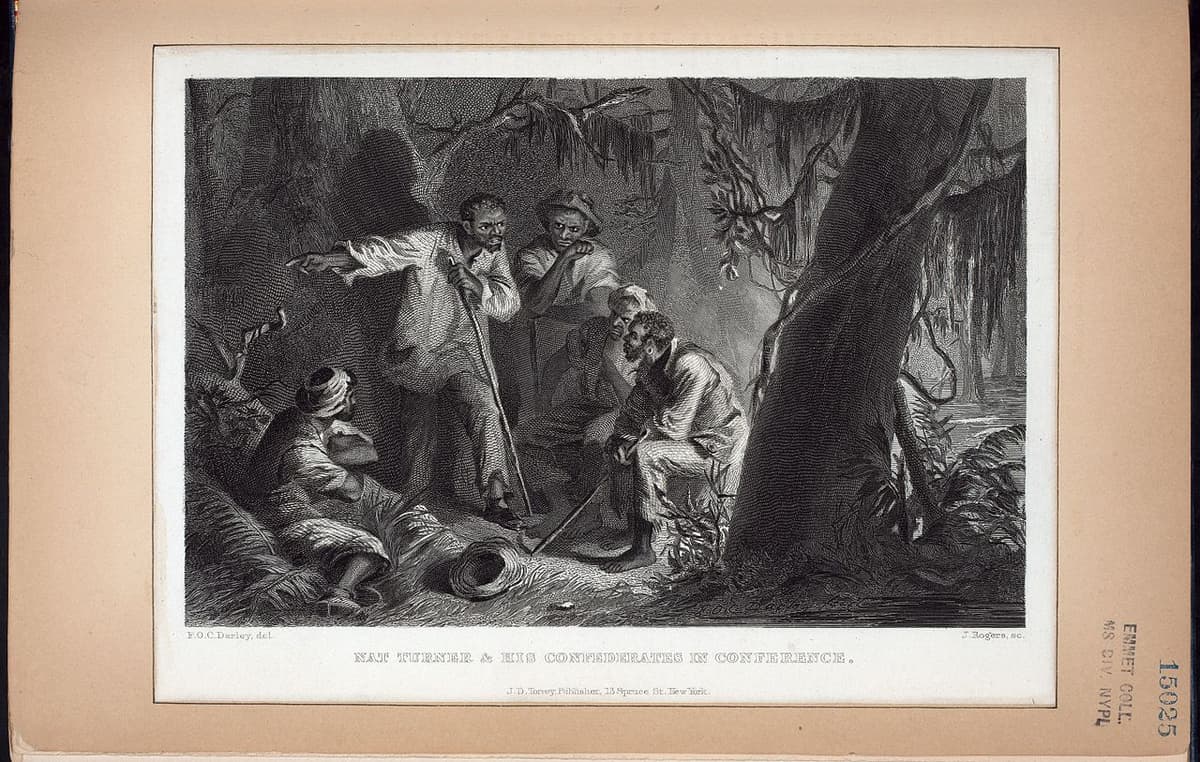Nat Turner, Prophet of the Most Successful American Slave Revolt, Doing God’s Work
The power of this ‘visionary history’ is its determination to re-create what Nat Turner experienced: apparitions of a white/Black conflict that he believed were divinely inspired.

‘Nat Turner: A Visionary History’
By Anthony E. Kaye with Gregory P. Downs
Farrar, Straus and Giroux, 434 Pages
In August 1831, a slave, Methodist preacher, and prophet named Nat Turner led the only successful slave revolt in American history, one that left 55 white men, women, and children dead in a two-day period that terrified and enraged the inhabitants of Virginia’s Southampton County and slaveholders across the nation.
A white attorney, Thomas Gray, published a pamphlet, “The Confessions of Nat Turner,” based on an interview with him in his jail cell awaiting execution, and came away with a deep respect for the intelligence and dedication of a man so eloquent that he became the subject of William Styron’s beautifully written novel using Gray’s title. It depicts the dignity of what others called a mass murderer but whom James Baldwin deemed, after reading Styron’s novel, part of “the common history—ours.”
Gray initially treated Turner as a religious fanatic, as did other whites and perhaps some fellow slaves who refused to join his revolt and even defended the lives and property of their slave masters. An African American writer, Arna Bontemps, who wrote “Black Thunder,” a novel about an attempted slave rebellion in 1800, rejected Nat Turner as a subject because of his grisly religious fanaticism.
Anthony E. Kaye died before completing his biography of Turner, treating him as not that different from biblical prophets who resorted to violence until the walls of oppressors came tumbling down. Gregory B. Downs assembled and rewrote what Kaye had drafted, explaining his effort to do justice to a monumental work of reclaiming the life of a much misunderstood leader of a liberating force.
The power of this “visionary history” is its determination to re-create what Nat Turner experienced: apparitions of a white/Black conflict that he believed were divinely inspired. He joined a generation and more of Methodists who had prophetic and sometimes violent visions and spoke of them to congregations of Black and white people mixed together.
As Mr. Downes suggests, Turner may well have been aware of slaves, promised their freedom, who had fought on the British side in the American Revolution and in the War of 1812. Turner was literate, though what he read, other than the Bible, is not known. It might be supposed after reading Gray’s “Confessions” that Turner’s articulate answers to the lawyer’s questions were translated, so to speak, in the lawyer’s style, yet there is plenty of evidence to show that Turner spoke as well as, say, Frederick Douglass.
Turner comes alive in Mr. Downes’s narrative as a self-taught military man, knowing quite well the odds were against him but nonetheless hoping that his surprise attack on the whites would rouse his fellow slaves to join him and amass a sufficient force to take the nearby town of Jerusalem — the very name of which probably galvanized Turner’s desperate drive toward a freedom he had spent his life dreaming of in a period when manumission still seemed possible but increasingly improbable as the whites kept acquiring more land and slaves.
Gray supposed that the imprisoned Turner would have to admit he had failed. Yet Turner, who had patiently answered all of Gray’s questions, as well as the interrogation of other whites, rose up in Gray’s presence and replied: “Was Christ not crucified?” In short, this was a prophet aware that prophets before him had also been defeated and yet, in the end, triumphed.
Throughout Mr. Downs’s narrative, Turner is treated with deep respect as a man who took years to formulate his plans, and in the midst of battle figured out when to attack, when to retreat, and surveyed the various scenes of conflict very much as a general would do.
Still, much about Nat Turner’s revolt remains occluded, and Mr. Downs never pretends to know more than the evidence suggests. Sometimes whole paragraphs are studded with “perhaps,” but that is appropriate because every possible choice and alternative has to be canvassed, just as Turner himself had to do — delaying plans, then boldly going onward before he lost some of his soldiers (probably never more than 40), who were, as the hymn says, always Christians, doing, in Turner’s view, God’s work.
Mr. Rollyson’s undergraduate senior thesis at Michigan State University was about Nat Turner and the fiction and history he inspired.

